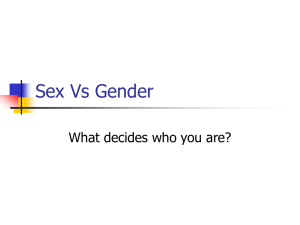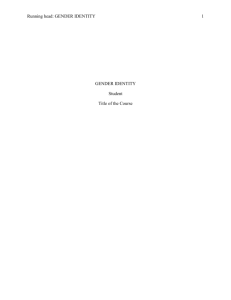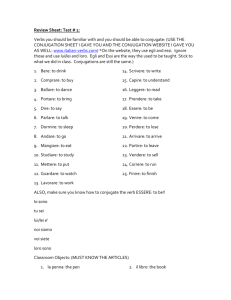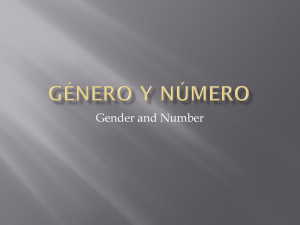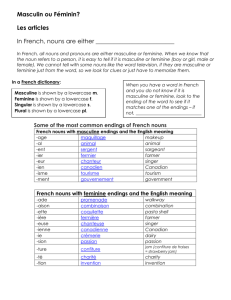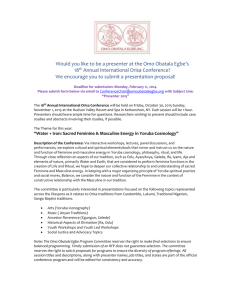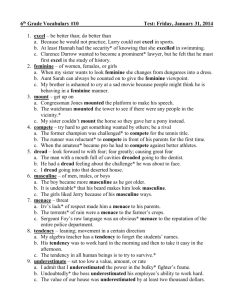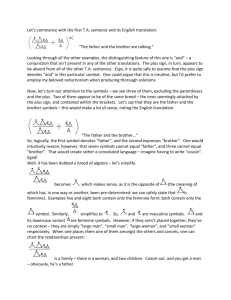Recognizing the Essential Nature of the Masculine and the Feminine
advertisement
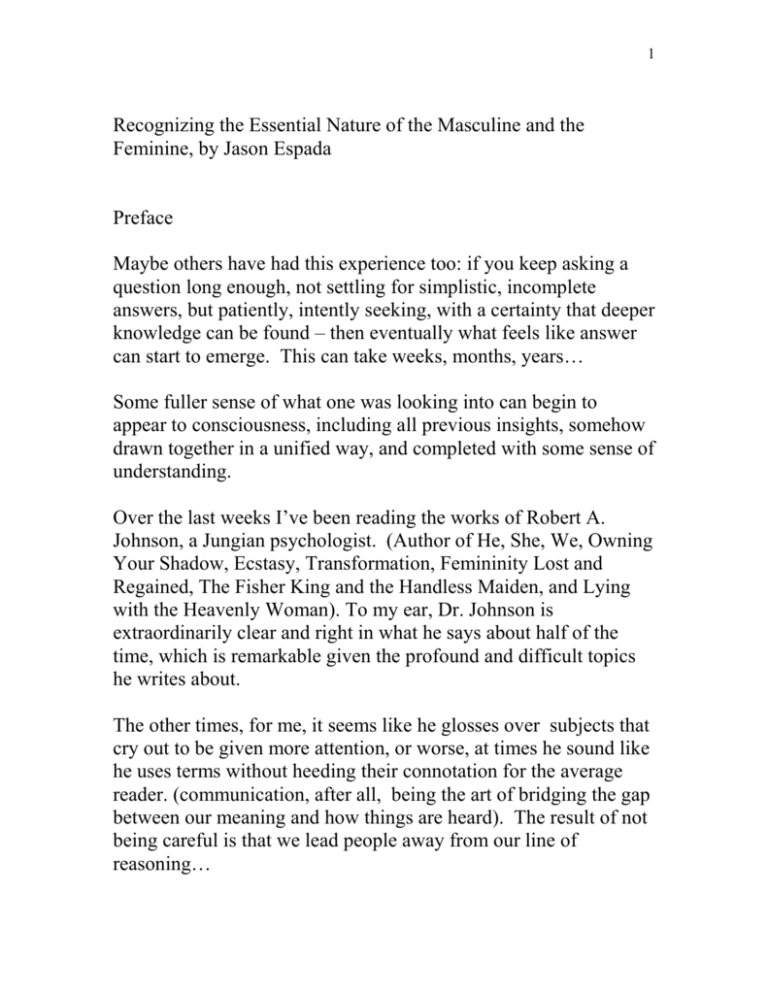
1 Recognizing the Essential Nature of the Masculine and the Feminine, by Jason Espada Preface Maybe others have had this experience too: if you keep asking a question long enough, not settling for simplistic, incomplete answers, but patiently, intently seeking, with a certainty that deeper knowledge can be found – then eventually what feels like answer can start to emerge. This can take weeks, months, years… Some fuller sense of what one was looking into can begin to appear to consciousness, including all previous insights, somehow drawn together in a unified way, and completed with some sense of understanding. Over the last weeks I’ve been reading the works of Robert A. Johnson, a Jungian psychologist. (Author of He, She, We, Owning Your Shadow, Ecstasy, Transformation, Femininity Lost and Regained, The Fisher King and the Handless Maiden, and Lying with the Heavenly Woman). To my ear, Dr. Johnson is extraordinarily clear and right in what he says about half of the time, which is remarkable given the profound and difficult topics he writes about. The other times, for me, it seems like he glosses over subjects that cry out to be given more attention, or worse, at times he sound like he uses terms without heeding their connotation for the average reader. (communication, after all, being the art of bridging the gap between our meaning and how things are heard). The result of not being careful is that we lead people away from our line of reasoning… 2 Strange to say, it seems I’ve gotten even more from the places where I feel this author has missed or has not stated things fully. Whether or not he’s intended readers to engage his short works this way, they have brought to the surface my own thoughts on these subjects. I would also here like express my gratitude for the works of Thomas Ashley-Ferrand. To my knowledge they are unique in their range and their depth, and he makes Indian Traditions accessible for modern Westerners. Mr. Ashley-Ferrand also has many profound and useful things to say about the nature of masculine and feminine, and their relationship. The Masculine and the Feminine It’s only at this point in my life that I can see what we call the masculine and the feminine consistently with clarity and with comprehension. I am indebted to all my teachers, and most recently to Robert Johnson for his work and reflections, for the vocabulary he offers, and for his stimulating ideas. I’ll be referring to some of his thoughts in the course of this paper. Two Essential Points Two points come up consistently for me now in thinking about the nature of the masculine and the feminine. The first is that they are inseparable. We can seem to divide them with words, but in actuality what we call masculine and feminine qualities or characteristics are, by their very nature, always present together. (more on that later). Not recognizing this, but instead thinking of them as fundamentally separate is basically just a wrong perception. 3 Not to dwell in conjecture and mere ideas – this can be proven, and in fact needs to be proven, like any other truth, by each person for themself. The masculine and feminine are a fundamental unity, but our language and thinking about them, and later our experience can make them seem like two things. Which leads me to the second point that comes to me frequently when thinking about the masculine and feminine. There is a verse by the Indian Buddhist Saint, Dharmakirti that says, essentially, when we understand how thinking effects our experience, we can begin to see how things actually exist. The reason this came up again and again while reading Dr. Johnson’s works was that I repeatedly had the experience, when he would refer to the masculine or feminine, of what is called ‘re-ification’. This means making something seem to be solid, or fixed in nature, limited to just what is immediately present or tangible to our mind. Things are changing all the time, and there is more to what is here that what we usually see at one glance. What we grasp then, in this limited way when we refer to the masculine or the feminine, misses the dynamic nature of what is actually here. I wrote the following to a friend, about how Taoism views what we call the masculine and feminine: In Taoism, the masculine and the feminine principles are called yin and yang. These are recognized as two expressions of the one life force, or Tao. They are always found together in life. Although we may see just one side, when one quality is there and working in a balanced way, the other is there in a healthy way as well. 4 I have the image of a ball, maybe the size of a softball, held in the hand – one side is blue, and the other, red. Showing the blue half, if we look closely, we can see that behind it is red. It’s like this. Whenever we see one quality in what we would call a balanced expression, the other is there behind it, supporting it. It may be worth quoting here a bit more from the beginning of that letter: Distinguishing masculine and feminine qualities from the male and female gender In this culture at this time there is a lot of confusion about what it means to be a man, and what it means to be a woman. The discussion of masculine and feminine qualities themselves should not be confused with the male and female gender. Neither should it be taken as having the aim of making a man more masculine, or a woman more feminine. Every person has both masculine and feminine qualities, in different amounts. That should be respected. That is how it is, and as it should be. What balance means is different for each of us, but seeking balance is natural to us all. In fact, we can say that the masculine and feminine qualities in us themselves need the other for balance, and to reach their full potential. In Taoism, balanced expression is called ‘true yang’, or ‘true yin’, and when out of balance, these expression are called ‘abberant yang’ or ‘abberant yin’. I recently found a poem I wrote a number of years ago, that has the first lines: The sunlight is all full of night 5 this deep rest gives it its power… I know now that what we see as expressions of these principles, the masculine and the feminine, are more often than not based on a wrong or rather an incomplete knowledge of what is the masculine and what is the feminine. I think of an effeminate man, with a screeching voice – something in me feels uncomfortable. His voice makes me uneasy – it seems as though there is something uncomfortable in himself; then I think of teachers I’ve known, both men and women who have these elements, the masculine and feminine present and in some balanced, harmonious relationship. It is there in their voice, and this brings comfort. The danger when we don’t have enough role models is that we easily develop wrong ideas about the nature of the masculine and the feminine. We learn to see ourselves and others and the world in a mistaken way. We do need this kind of knowledge then so that we don’t suffer and cause others to suffer. Yin without true yang is suffering Yang without true yin is suffering Again, not that they can ever be separated, but it is possible for the masculine in us to not be complemented, completed, or fulfilled by the true feminine, and it is possible for the feminine not to have enough of the true masculine to bring balance and fulfillment, and for this element, in turn, to be true feminine… (see my eight pages of notes on other pages: Masculine and Feminine Qualities and Their Shadows for descriptions of the various expressions of the masculine and the feminine) 6 If the masculine in us is ‘fed’ with, or meets only with aberrant yin – the feminine in an unbalanced or not completed expression – the result is aberrant yang – unfulfilled, unbalanced masculine. Likewise, if the feminine aspect only meets (internally, externally) with immature, unbalanced or incomplete masculine energies, male not really male, masculine not truly masculine, the result is aberrant yin – the unbalanced feminine quality, unfulfilled, incomplete and not capable then of being true yin or the feminine to the masculine in life (inside, outside; within ourselves, in our relationships and in the world). Some of the characteristics of unbalanced, incomplete, unfulfilled masculine energies are things such as: violence, aggression, destructiveness, cruelty, lack of feeling. Some of the characteristics of the unbalanced, incomplete, unfulfilled feminine are: greed, attachment, coldness, manipulation, and barren-ness. When the true masculine and feminine are unified (their unity realized, through whatever ways we get there) the result is that a person is nourished in all aspects; life is fruitful and creative; there is rest, health, joy, and a flowering of life. The hermaphrodite and the androgyny as psychological symbols In art and in myth, the hermaphrodite and the androgyny are representations of inner, psychological realities. There is important distinction between them that has to do with differentiation - the process of self actualization, or becoming, the full expression of qualities. 7 The difference is that in a hermaphrodite, there is less development of the different masculine and feminine factors, and yet they are visibly, manisfestedly there together, or combined. The result is usually shocking, or somewhat repulsive, or as though some work is not yet finished, not yet complete. The androgyny on the other hand has had both the true masculine and the feminine qualities developed, and then they are recombined, or brought back together into some sort of higher creative way. A note on levels: In any discussion of the masculine and feminine, again, we need to remember that we are talking about inner, psychological realities. This should not be confused with the outer levels of our being (as could be the case with hermaphrodite-ism, gender confusion, or the lack of differentiation of the masculine and the feminine in us). Every person is, inwardly, a unity, with greater or lesser degrees of actualizing this unity in his or her life. It’s important not to mix up the levels, as they say in psychology. This is like Don Quixote ‘tilting at windmills’ in stead of doing his inner work; or like a man, in touch with his feminine side, attempting to breast feed a child. Our physiology and our psychology, our body and our inner life, are part of one reality, but they exist on different levels. We should be clear about this. When a person is aware of the androgynous nature of the human soul, both masculine and feminine qualities are there, and tangibly expressed (this is like looking at something with two aspects and seeing both aspects at the same time, not in alteration, but some of each - like a red/blue ball. 8 Actually what I'm talking about here with the masculine and feminine holds more than this analogy - the different aspects, male and female in fact have a creative, nurturing, sustaining, and augmenting relationship to each other. There is a significant difference that is being pointed to between the hermaphrodite and the androgyny in terms of inner development. I read this recently in Dr. Johnson’s work, and it makes sense. It seems that we have to bring out the male and female qualities separately before they can be brought back together, and balanced, re-combined (even though on another level they never were entirely separate). The process seems natural and important for our becoming as individuals, for our growth, maturity, and understanding. Like bread rising like a pregnant woman’s stomach swelling with life like flowers opening in the spring sun like summer’s abundant harvests In Tibetan Buddhism, sometimes we see thankas (religious paintings embroideries) that show ‘deities in embrace’. The meaning of this symbol is creative unity – not two things, but a fundamental, naturally existing unity beyond duality. For someone who is trained in this tradition, reflecting on the symbol can produce in their consciousness something of the experience that is represented. Some presentations of their teachings on meditation divide cultivation / practice into ‘meditation with support’ and ‘meditation without support’. When images are used, the practice 9 is done beginning with no images whatsoever in mind, and ending also with the total dissolving of images. This is done to avoid confusion, and to more fully integrate what was experienced. This is certainly a valid approach. In the Indian Tradition also, Divinities (aspects of ourself) are often referred to in pairs. This is meant to teach us how things are in reality. Two places not to look for the archetype of the masculine and feminine We usually start our search for principles, such as the male and the female, in the wrong places. (Maybe this is a natural process – first starting with where truth is not found). Usually we look for the male ideal and the female ideal in those closest to us – first in our parents and relationships, and then in our history (including modern culture). But our parents and the people we are involved with were and are a mix, like all people, of the masculine and the feminine. And not only that, unless they were exceptional people in this regard, they had some true yin mixed with the aberrant feminine, or, in the case of the masculine, some true yang qualities mixed with the aberrant, not archetypal, unfulfilled, incomplete ‘masculine’. Then, in our histories too, and modern culture, people are a mixture. And looking there we are more likely to see what the masculine and feminine are not than to see its’ true face, or to get a clear sense of what these elements are ideally. So, where do we find the actual, ideal feminine, or the essential, original masculine? I would propose that to see these things 10 properly we need to have some contemplative life functioning. We have to look within and contemplate these things carefully for them to appear clearly in our mind. That is the first thing. It doesn’t matter how many books we read or discussions we have or programs we watch. What matters, and a decisive factor here is the depth and clarity of our own experience. From what I can tell, that’s where these things begin to really show themselves. In approaching the spectrum of the masculine and the feminine, the starting place is our own observation and contemplations. Next, after being in nature, and our own direct observations of ourselves and this world, I am of the belief that we can all benefit from myth and religious study. If we remember all along the way that we are talking about inner elements, inner dynamics, that cannot be separated – male from the female, then myth and the study of Traditions can serve to awaken a sense of who we are, and who we can be. Myth, or stories can be from the culture closest to us, or from another culture, from long ago or from something closer to modern times. The only thing that matters is that they speak to us on a deep level of universal truths. Jails and Monasteries It occurred to me recently that there are two environments where men and women are separated. One as a punishment, and one that is entered into voluntarily, with the intention of leading to a greater fulfillment. Jails are places of punishment. And one of the first things to be taken from a person, after their freedom to go where they want, is the company of the opposite sex. Implied is the suffering that 11 would usually cause. For people that don’t know anything of the inherent wholeness of a person, to be without the other gender is torment. On the other hand, when entering a monastery, or a retreat situation, men and women of all times have separated themselves from the other gender in order to foster the sense of completion within themselves (ideally, that is). However they may call it – God, nirvana, enlightenment – it is a state not found outside ones’ self, and where nothing is lacking. And not only is nothing lacking, we can say it is fulfillment itself, overflowing, gracing all the world. I admit, it is very difficult to have this sense if we, and if others around us are not working towards this awareness of the self as complete. If others around us see themselves and view the person as fundamentally incomplete, then they will certainly pursue what they think will bring fulfillment – relationships, possessions, accomplishments. And this will effect how we see ourselves and others, and that can make it difficult to find our way. If we are not in a monastery (and few of us are) or retreat, then we need to make even more of an effort to have time to reflect, in an unhurried way, and to distance ourselves from other people, and to ‘sift out’ ideas and information that is not of our own choosing. This is the only way to separate truth from falsehood, right ideas and values from those that are mistaken. What then of relationships? Outer relationships can certainly help us to fulfill our purpose in life, but as it is today, most of the time they are sought as a substitute for something that can only be found in our own souls. 12 (See Robert Johnson’s book ‘We’ for a full discussion of the process of what usually happens in romantic relationships). This often involves investing the other with the exclusive possession of a feminine or masculine characteristic. It may be in them too, but it is a huge mistake to think it is only there. This leads to desperate attachment, and feelings of profound loneliness when not with the other. Relationships like that are not stable, because we are not meeting the other as a complete human being, or on the way to ourselves and to the other’s becoming a complete human being. We see each other instead as a means to completion, as a necessary complement. It’s something of a mistake to think this way, when it is based on a wrong perception about ourselves and others. At their best, relationships can help us to learn about ourselves and to express what we were born to express with our life. They can help us to find and to actualize what we each can become. They can help us to bring forth our best self. Honoring that with high intention and with clear eyes, all our relationships will be positive, fruitful, and life affirming; joy and nourishment for ourselves, for others, and for the world. Like breathing There are some characteristics that seem to me to be mis-categorized as being either masculine or feminine. An example: feeling is usually given as a feminine quality, and thinking as masculine. Strength is another, usually attributed to the masculine, and softness, grace and beauty as feminine. 13 Perhaps it’s truer to say we see these aspects, and there is a deeper truth to them. (at times when I dwell on these things and start looking for and seeing the masculine and feminine everywhere, I feel like I’m looking at and talking about the basic building blocks of reality; reflections take on a ‘primordial’ character) Again, I think it’s necessary to bring to mind the idea I mentioned on page 3 of this paper, that we need to understand how out mind and thinking effects what we experience. I can see that when we give something a name, (like masculine or feminine) there is usually the feeling right away of resistance to it’s being anything else. I call that grasping too much at our ideas. But if things are transforming all the time, one thing into another, well, what then? We can at least aim to ‘hold our ideas lightly’ so that things can show themselves a bit more for what the actually are. Now, when I come across some quality or experience, such as love, generosity, gratitude or gentleness, I look to see if it isn’t more of a combination of masculine and feminine – like breathing, or sitting, or walking, or looking. Things seem to have both elements in them. I get the feeling that masculine and feminine are different characteristics of one reality experienced at different times. Not one better or worse, or one originally coming first, but appearing as they do when we meet them. Remember earlier when I said that the masculine and feminine were like a ball, one side the color blue, the other the color red? Well, sometimes, instead of just seeing the one color behind, 14 I see it as part one and part the other, or as even turning before my eyes. This seems to be more true as an analogy. Here is the complete short poem on yin-yang, masculine-feminine that I quoted the first line of earlier: The sunlight is all full of night this deep rest gives it its power Within each of the forms given by the earth we taste the source in cool stillness These ways are turning in a perfect circle The mother spirit gives birth to the father spirit whose power and grace derives from silence, perfect peace, unity, wholeness flowing through his hands and arms born man and woman each become the other Nurturance, and the home of fortitude becomes all the shining spheres of creation I watch how these things transform, and that is as true as I can say it - that one becomes the other in some profound way. If you can think of being nourished by some deep feeling of peace, like rest, blissful, restorative, and then from that comes all the energy to live and move through your day, creatively, with abundant energy... it's like this... that energy came from somewhere … This idea is reflected in the I Ching. As I understand it, the first two hexagrams are, 1., The Creative (the masculine principle), and 2., The Nurturant (or The Receptive) (the feminine principle). Within the Creative is the Nurturant, showing itself in this way; and within the Nurturant is the Creative, showing itself in this way. 15 I think there is a lot to be gained from the symbol of the Tao: one half of it is dark with a small circle of light in the center, and the other half is light with a circle of dark- also, instead of being merely divided in half, the circle is represented as dark and light with a swirling movement to it... I think that means change, one expression into another... Looking at who we are and what we are, I find that I can best use the ideas of yin and yang as a starting point, for clarity’s sake. For one thing, there is not as much confusion around those terms, as there is around the connotations of masculine and feminine (let alone ‘male and female’). Second, when we look beyond human beings, to nature, we can learn a lot about ourselves. This is one of the fundamental insights of Taoism, and nature-oriented peoples. It’s clear that we as 21st century Westerners have a lot of need to un-do the confusion in our thinking. There’s an idea from Tibetan Buddhism, that says if something is mistaken, or not true, the more you investigate it, the more the wrong ideas fall away, or are seen for what they are; and that if something is true, the more you look at it, the more true it becomes. These few things, I’m surprised to say, I know for sure. They’ve proven reliable for me. It’s my wish that everyone have clear understanding of who they are, and that they thereby have peace, health and the most stable kind of happiness. If these pages in any way contribute to those aims for anyone else, that would be the most gratifying thing I can hope for.
